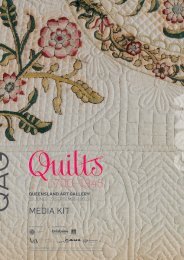Paperskin: barkcloth across the Pacific - Queensland Art Gallery
Paperskin: barkcloth across the Pacific - Queensland Art Gallery
Paperskin: barkcloth across the Pacific - Queensland Art Gallery
Create successful ePaper yourself
Turn your PDF publications into a flip-book with our unique Google optimized e-Paper software.
in New Zealand, people share a range of meanings and value around tapa despite <strong>the</strong><br />
culturally distinct manner in which <strong>the</strong>y are marked. in <strong>the</strong> diaspora, tapa mediates a<br />
form of cultural recovery in a global maelstrom. i think that, for many <strong>Pacific</strong> islanders<br />
in New Zealand, regardless of <strong>the</strong>ir origins or descent, <strong>barkcloth</strong> is symbolic of an<br />
idealised past (or present) way of life that is geographically distant. Tapa is a tangible<br />
link to ‘a past’ as well as a signifier of cultural conditions in <strong>the</strong> present. indeed, Fijian<br />
Nina Nawalowalo has described masi as a ‘map back to my own cultural roots’ with<br />
‘<strong>the</strong> fibres’ providing a way back ‘to a time and place’. 9 What <strong>the</strong> case studies above<br />
have in common is <strong>the</strong> deployment of tapa as a tool for bringing <strong>the</strong> past closer to <strong>the</strong><br />
present. Tapa, like o<strong>the</strong>r cultural productions, is used in ‘<strong>the</strong> mediation of ruptures of<br />
time and history — to heal disruptions in cultural knowledge, historical memory, and<br />
identity between generations’, people and places. 10 in this way, people can lay claim to<br />
a cultural or ethnic identity through <strong>the</strong> process of using a ‘thing’, whe<strong>the</strong>r it is tapa, <strong>the</strong><br />
haka, or tattoos. The ceremonies tapa mediates, like <strong>the</strong> events for which it serves as a<br />
backdrop, are expressions of connectedness.<br />
Ngatu is also made from syn<strong>the</strong>tic material in transnational Tongan communities.<br />
like <strong>the</strong>ir organic counterparts, syn<strong>the</strong>tic ngatu pieces are used in presentations, as<br />
wrappings, and are also given as gifts. Tongan ngatu artists who produce syn<strong>the</strong>tic<br />
tapa indicate a preference for indigenous materials, but, <strong>the</strong>y say, <strong>the</strong>y will use syn<strong>the</strong>tic<br />
tapa for <strong>the</strong>ir presentations if necessary. As anthropologist roger Neich has argued, for<br />
items of samoan cultural value such as <strong>the</strong> ie toga (cloth for toga) 11 , often <strong>the</strong> aes<strong>the</strong>tic<br />
focus is not only on how <strong>the</strong> item appears, but also what it represents for <strong>the</strong> event or<br />
context in which it mediates <strong>the</strong> ceremony and actions surrounding its presentation or<br />
use. This would explain how Tongan ngatu can be used at a samoan wedding, or a<br />
funeral, or worn by a samoan chief’s daughter in a performance. 12<br />
This is not to say <strong>the</strong> markings on tapa’s paperskin are unimportant, but to highlight<br />
that <strong>the</strong>y coexist with o<strong>the</strong>r dimensions of meaning and interpretation. We seek <strong>the</strong><br />
‘materiality’ of <strong>barkcloth</strong> not only for its markings but also for its qualities as something<br />
made by human hands, a cloth crafted. We seek its power to bring <strong>the</strong> past, people,<br />
history and <strong>the</strong> islands closer — to make <strong>the</strong>m tangible. <strong>barkcloth</strong> connects us in a way<br />
that fascinates, entrances and inspires us.<br />
The meanings of <strong>barkcloth</strong> are as unfixed and changing as <strong>the</strong> identities of <strong>the</strong> people<br />
who use <strong>the</strong>m. if an object’s value is dependent on context we cannot assume a<br />
completeness of cultural transmission despite an increasingly transnational and<br />
interconnected world. When thinking about <strong>barkcloth</strong> we have to consider disjunctions<br />
between <strong>the</strong> spaces where <strong>the</strong>y originate and <strong>the</strong> meanings people give to, and make<br />
through, <strong>the</strong>m in new locations. These circumstances create room for us to celebrate<br />
<strong>barkcloth</strong> as a form of beautifully inscribed paper skin from <strong>Pacific</strong> places distant in time<br />
and location. They also allow us to probe beyond this veneer for a significance that is<br />
deeper and closer to home.<br />
Sean Mallon is senior Curator, <strong>Pacific</strong> Cultures at <strong>the</strong> Museum of New Zealand Te Papa Tongarewa.<br />
28<br />
Siapo or Ngatu c.1955<br />
Samoa or Tonga<br />
Barkcloth, dye / 176.5 x 84.7cm /<br />
Collected by Sir Guy Richardson<br />
Powles c. 1949-60. Gift of<br />
Michael Powles, 2001. Collection:<br />
Museum of New Zealand Te<br />
Papa Tongarewa<br />
29

















